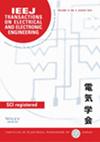Yanzhen Li, Haixin Wang, Zihao Yang, Fausto Pedro Garcia Marquez, Zhe Chen, Junyou Yang, Yunlu Li
求助PDF
{"title":"A Feature Engineering-Based NILM Framework for Appliance Recognition Considering Data Class Imbalance","authors":"Yanzhen Li, Haixin Wang, Zihao Yang, Fausto Pedro Garcia Marquez, Zhe Chen, Junyou Yang, Yunlu Li","doi":"10.1002/tee.24164","DOIUrl":null,"url":null,"abstract":"<p>Due to the diversity and randomness of residential consumption behavior, as well as the different share of domestic electricity demand by appliances, class imbalance problems exist in the non-intrusive load monitoring (NILM) system. The recognition model becomes biased toward the majority class, which makes the recognition of the minority class difficult. To tackle this challenge, we propose a novel NILM framework for appliance recognition to overcome the insufficient learning problems of the minority class, which combines a multi-domain feature extraction module, a two-stage feature selection, and a data oversampling method. Multiple features are extracted to make full of the complementarity of combined features to enhance appliance recognition. Furthermore, a two-stage feature selection based on minimal-redundancy-maximal-relevance (mRMR) and random forest (RF) is developed to select an optimal feature set. Subsequently, an oversampling method combining K-medoids and the synthetic minority oversampling technique (KM-SMOTE) with sampling weights is proposed for data augmentation of the minority class to handle imbalance learning problems. The effectiveness of the proposed method is verified by the experiments on the public dataset PLAID. The results show that, compared with the state-of-the-art techniques, the overall recognition accuracy and F1-score with the proposed method are enhanced by 4.61% and 2.04%, respectively. © 2024 Institute of Electrical Engineers of Japan and Wiley Periodicals LLC.</p>","PeriodicalId":13435,"journal":{"name":"IEEJ Transactions on Electrical and Electronic Engineering","volume":"19 12","pages":"2012-2023"},"PeriodicalIF":1.0000,"publicationDate":"2024-07-18","publicationTypes":"Journal Article","fieldsOfStudy":null,"isOpenAccess":false,"openAccessPdf":"","citationCount":"0","resultStr":null,"platform":"Semanticscholar","paperid":null,"PeriodicalName":"IEEJ Transactions on Electrical and Electronic Engineering","FirstCategoryId":"5","ListUrlMain":"https://onlinelibrary.wiley.com/doi/10.1002/tee.24164","RegionNum":4,"RegionCategory":"工程技术","ArticlePicture":[],"TitleCN":null,"AbstractTextCN":null,"PMCID":null,"EPubDate":"","PubModel":"","JCR":"Q4","JCRName":"ENGINEERING, ELECTRICAL & ELECTRONIC","Score":null,"Total":0}
引用次数: 0
引用
批量引用
Abstract
Due to the diversity and randomness of residential consumption behavior, as well as the different share of domestic electricity demand by appliances, class imbalance problems exist in the non-intrusive load monitoring (NILM) system. The recognition model becomes biased toward the majority class, which makes the recognition of the minority class difficult. To tackle this challenge, we propose a novel NILM framework for appliance recognition to overcome the insufficient learning problems of the minority class, which combines a multi-domain feature extraction module, a two-stage feature selection, and a data oversampling method. Multiple features are extracted to make full of the complementarity of combined features to enhance appliance recognition. Furthermore, a two-stage feature selection based on minimal-redundancy-maximal-relevance (mRMR) and random forest (RF) is developed to select an optimal feature set. Subsequently, an oversampling method combining K-medoids and the synthetic minority oversampling technique (KM-SMOTE) with sampling weights is proposed for data augmentation of the minority class to handle imbalance learning problems. The effectiveness of the proposed method is verified by the experiments on the public dataset PLAID. The results show that, compared with the state-of-the-art techniques, the overall recognition accuracy and F1-score with the proposed method are enhanced by 4.61% and 2.04%, respectively. © 2024 Institute of Electrical Engineers of Japan and Wiley Periodicals LLC.
考虑到数据类别不平衡的基于特征工程的 NILM 家电识别框架
由于居民消费行为的多样性和随机性,以及家用电器在家庭用电需求中所占比例的不同,非侵入式负荷监测(NILM)系统中存在类别不平衡问题。识别模型会偏向于大多数类别,这就给识别少数类别带来了困难。为解决这一难题,我们提出了一种新型的 NILM 框架,该框架结合了多域特征提取模块、两阶段特征选择和数据超采样方法,用于家电识别,以克服少数类别学习不足的问题。该方法结合了多域特征提取模块、两阶段特征选择和数据超采样方法,提取多个特征,充分利用组合特征的互补性来提高家电识别率。此外,还开发了基于最小冗余-最大相关性(mRMR)和随机森林(RF)的两阶段特征选择,以选择最佳特征集。随后,提出了一种结合 K-medoids 和带有采样权重的合成少数群体超采样技术(KM-SMOTE)的超采样方法,用于增加少数群体类别的数据,以处理不平衡学习问题。在公共数据集 PLAID 上的实验验证了所提方法的有效性。结果表明,与最先进的技术相比,所提方法的整体识别准确率和 F1 分数分别提高了 4.61% 和 2.04%。© 2024 日本电气工程师学会和 Wiley Periodicals LLC.
本文章由计算机程序翻译,如有差异,请以英文原文为准。

 求助内容:
求助内容: 应助结果提醒方式:
应助结果提醒方式:


